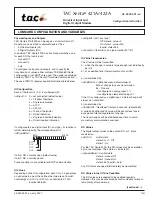
Protected zone
Comm. Channel
IEC05000040_2_en.vsd
IED
IED
IED
Comm. Channel
Comm. Channel
IEC05000040 V2 EN-US
Figure 7. Example of application on a three-terminal line with 1½ breaker arrangements
The current differential algorithm provides high sensitivity
for internal faults and it has excellent stability for external
faults. Current samples from all CTs are exchanged
between the IEDs in the line ends (master-master mode) or
sent to one IED (master-slave mode) for evaluation.
A restrained dual biased slope evaluation is made where
the bias current is the highest phase current in any line end,
giving a secure through-fault stability even with heavily
saturated CTs. In addition to the restrained evaluation, an
unrestrained (instantaneous) high differential current setting
can be used for fast tripping of internal faults with very high
currents.
A special feature with this function is that applications with
small power transformers (rated current less than 50% of
the differential current setting
IdMin
) connected as line taps
(that is, as shunt power transformers), without
measurements of currents in the tap, can be handled. The
normal load current is considered to be negligible, and
special measures must be taken in the event of a short
circuit on the LV side of the transformer. In this application,
the tripping of the differential protection can be time-
delayed for low differential currents to achieve coordination
with downstream overcurrent IEDs. The local protection of
the small tap power transformer is given the time needed to
disconnect the faulty transformer.
A line charging current compensation provides increased
sensitivity of line differential protection.
Line differential protection 3 or 6 CT sets, with in-zone transformers LT3CPDIF , LT6CPDIF
M14932-3 v9
Two two-winding power transformers or one three-winding
power transformer can be included in the line differential
protection zone. In such application, the differential
protection is based on the ampere turns balance between
the transformer windings. Both two- and three-winding
transformers are correctly represented with vector group
compensations made in the algorithm. The function includes
2
nd
and 5
th
harmonic restraint and zero-sequence current
elimination. The phase-segregated differential protection
with single-pole tripping is usually not possible in such
applications.
IED
IED
IED
Protected zone
Comm. Channel
Comm. Channel
Comm. Channel
IEC05000042_2_en.vsd
IEC05000042 V2 EN-US
Figure 8. Example of application on a three-terminal line with an in-line power transformer in the protection zone
Analog signal transfer for line differential protection
M13647-3 v9
The line differential protection function can be arranged as
a master-master system or a master-slave system
alternatively. In the former, current samples are exchanged
between all IEDs, and an evaluation is made in each IED.
This means that a 64 kbits/s or 2 Mbit/s communication
channel is needed between every IED included in the same
line differential protection zone. In the latter, current
samples are sent from all slave IEDs to one master IED
where the evaluation is made, and trip signals are sent to
the remote ends when needed. In this system, a 64 kbits/s
or 2 Mbit/s communication channel is only needed between
the master and each one of the slave IEDs. The Master-
Slave condition for the differential function appears
Line differential protection RED670
1MRK 505 379-BEN R
Version 2.2
34
Hitachi Energy
© 2017 - 2022 Hitachi Energy. All rights reserved
















































